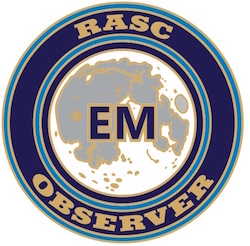Explore the Moon—an introductory lunar observing program
 This observing program (awarded since 2016) bridges the gap between the introductory Explore the Universe observing program and the comprehensive Isabel Williamson Lunar Observing Program. It is ideal for beginning observers who are just learning about telescopes and binoculars, by providing a hands-on observing experience on an easy object—the Moon. The telescope program is based on the 100 lunar features listed and charted in the RASC Observer's Handbook, originally selected by Roy Bishop. There is also a binocular program consisting of a reduced set of 40 features. We welcome feedback from observers!
This observing program (awarded since 2016) bridges the gap between the introductory Explore the Universe observing program and the comprehensive Isabel Williamson Lunar Observing Program. It is ideal for beginning observers who are just learning about telescopes and binoculars, by providing a hands-on observing experience on an easy object—the Moon. The telescope program is based on the 100 lunar features listed and charted in the RASC Observer's Handbook, originally selected by Roy Bishop. There is also a binocular program consisting of a reduced set of 40 features. We welcome feedback from observers!
Why Observe the Moon?
This may seem like a funny question. Many amateur astronomers, however, shun the Moon. It is true that moonlight interferes with the enjoyment of observing and photographing the “faint fuzzies,” which are deep-sky objects. A better option is to remain calm and observe the Moon on those nights when it dominates the sky. Here’s a list of benefits of lunar observing, particularly for beginning observers:
- It’s easy to find!
- You can observe from home, even in the city—no need to travel to a dark-sky site
- The Moon is bright, offering plenty of detail, even in small telescopes or binoculars
- Observing the Moon is ideal for learning how to operate your telescope and binoculars
- Finding the principal features is not hard, so you can learn observing skills
- It’s our nearest celestial neighbour!
Explore the Moon Program Guides
The two program guides Explore the Moon—binocular and Explore the Moon—telescope are self-contained, including a table of features, locations, and brief descriptions, plus enlargements of the Handbook maps (both standard view and mirror-reversed view, to match the observer's optics). There are suggested additional resources and step-by-step instructions on how to plan and carry out observing sessions (see below for a Photographic Album of EtM Features). The lunar features are ordered so that they can be observed night-to-night in order of their appearance during the waxing phases of the Moon (and they can also be observed disappearing during the waning phases). This program introduces the Q-day method of finding lunar features and timing observing sessions according to how many days it is before or after the first or last quarter of the Moon (this is unique to the RASC).
Observing (bookmark) list files for Stellarium are available at the RASC Toronto Centre web site.
Watch the various YouTube videos from the Moon At Noon series. With Jenna, John, Samantha and guest speakers.
Planning, Observing, and Recording
All the information you need is in the Explore the Moon—binocular or Explore the Moon—telescope guides below. You must keep a record of the date and time of observations, the sky conditions, the telescope or binocular characteristics, the magnification, and any observing remarks or details noticed. You are encouraged to include drawings or photographs, but it is not mandatory. Use the table in the guide itself as a checklist of completed observations, and indicate the location of the observaton in your record. Consider setting up a separate logbook for Explore the Moon, for ease of validation, using the generic logbook forms, below. There are other resources available below, such as a spreadsheet cross-referencing this program with the Isabel Williamson Lunar Observing Program, chart numbers in two lunar atlases, and a photographic guide to the EtM features.
Completing the Explore the Moon—telescope certificate does not make one eligible for the EtM—binoculars certificate. It is a unique certificate with a unique overall goal.
If you already hold one of the Explore the Moon certificates and are working on the other, we encourage you with the current instrument to make a new set of observations. Look again and enjoy the view.
RASC Explore the Moon Certificate
You must be an RASC member in good standing to receive a certificate. There are two ways to apply, using the generic application form: (1) have your observations validated by two local Centre observers and submit the application form with their endorsements, or (2) send the application form to the Chair of the Observing Committee with a record of your observations. Observers who qualify for the Observe the Moon—telescope certificate will also receive a colourful pin (see top of page).
Do not email large files or multiple files to the Observing Committee chair. Ask about our new Uploader Service!
Use the generic application form (PDF, 185 KB) for this visual certificate application. The form may be printed and completed by hand or filled in electronically. The form has a language of choice option for the Certificate. Indicate your home affiliated RASC centre or "National" or "Unattached" if not associated with a specific centre.
This Observing Program is designed to be an INDIVIDUAL EFFORT. When you complete the program and apply for your certificate, you will have met these requirements: you located the object yourself, made your own observation at the eyepiece, kept your own log book or pre-programmed observing forms, and then applied for your certificate on your own merit. Enjoy your journey through this program!
| Attachment | Size |
|---|---|
| 2.26 MB | |
| 565.7 KB | |
| 5.75 MB | |
| 4.74 MB | |
| 176.67 KB | |
| 179.22 KB | |
| 7.86 MB | |
| 25.64 KB |
